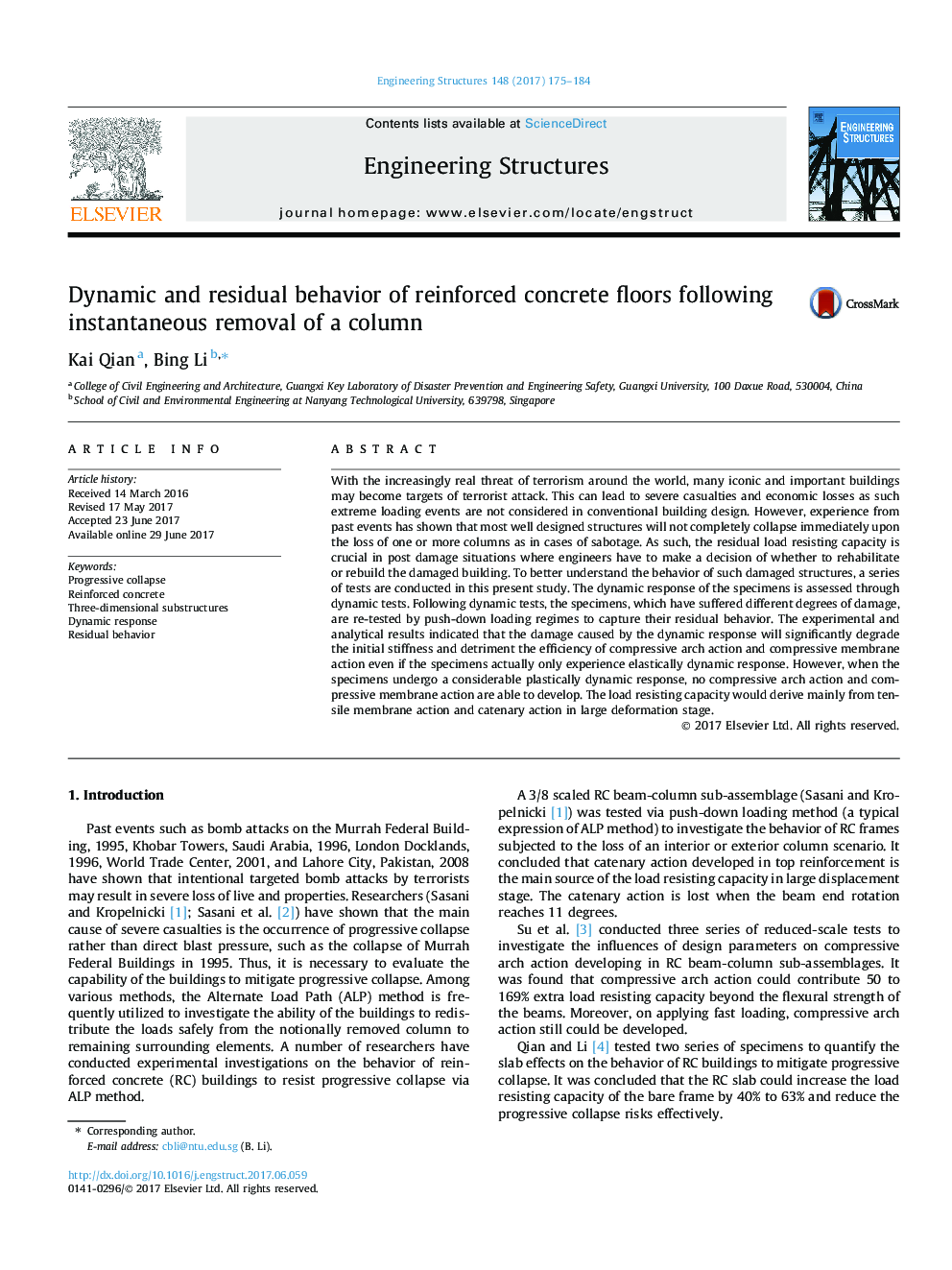| کد مقاله | کد نشریه | سال انتشار | مقاله انگلیسی | نسخه تمام متن |
|---|---|---|---|---|
| 4919991 | 1429079 | 2017 | 10 صفحه PDF | دانلود رایگان |
عنوان انگلیسی مقاله ISI
Dynamic and residual behavior of reinforced concrete floors following instantaneous removal of a column
ترجمه فارسی عنوان
رفتار پویا و باقی مانده از طبقه بتنی تقویت شده پس از حذف سریع ستون
دانلود مقاله + سفارش ترجمه
دانلود مقاله ISI انگلیسی
رایگان برای ایرانیان
کلمات کلیدی
سقوط پیشرو، بتن آرمه، زیر ساخت های سه بعدی، پاسخ دینامیکی، رفتار باقی مانده،
ترجمه چکیده
با تهدید فزاینده واقعی تروریسم در سراسر جهان، بسیاری از ساختمان های نمادین و مهم ممکن است به اهداف حمله تروریستی تبدیل شوند. این می تواند به تلفات شدید و زیان های اقتصادی منجر شود زیرا چنین رویدادهای بارگذاری افراطی در طراحی ساختمان متعارف در نظر گرفته نمی شود. با این حال، تجربه در حوادث گذشته نشان داده است که ساختارهایی که به خوبی طراحی شده اند، بلافاصله پس از از بین رفتن یک یا چند ستون به طور کامل در صورت خرابکاری، سقوط نخواهند کرد. به همین ترتیب ظرفیت مقاومتی باقی مانده در شرایط پس از آسیب پذیری بسیار مهم است که مهندسان مجبورند تصمیم بگیرند که آیا ساختمان آسیب دیده را بازسازی یا بازسازی کنند. برای درک بهتر رفتار چنین سازه های آسیب دیده، یک سری آزمایش ها در این مطالعه حاضر انجام می شود. پاسخ دینامیکی نمونه ها از طریق آزمون های پویا بررسی می شود. به دنبال تستهای پویای، نمونه هایی که در سطوح مختلف آسیب دیده اند، با رژیم های بارگیری فشار پایین برای ترسیم رفتار باقی مانده خود، دوباره آزمایش می شوند. نتایج آزمایشگاهی و تحلیلی نشان داد که آسیب های ناشی از پاسخ دینامیکی به طور قابل ملاحظه ای کاهش سختی اولیه و کاهش کارآیی عمل قوس فشاری و عمل غشاء فشاری را حتی اگر نمونه بطور واقعی واکنش دینامیکی الاستیک را تجربه کند. با این حال، هنگامی که نمونه ها تحت تاثیر قابل توجه پلاستیک دینامیکی قرار می گیرند، هیچ قوس فشاری و عمل غشای فشاری قادر به توسعه نیست. ظرفیت مقاومتی بار، به طور عمده از عمل غشای کششی و فعالیت کانکتور در مرحله تغییر شکل بزرگ حاصل می شود.
موضوعات مرتبط
مهندسی و علوم پایه
علوم زمین و سیارات
مهندسی ژئوتکنیک و زمین شناسی مهندسی
چکیده انگلیسی
With the increasingly real threat of terrorism around the world, many iconic and important buildings may become targets of terrorist attack. This can lead to severe casualties and economic losses as such extreme loading events are not considered in conventional building design. However, experience from past events has shown that most well designed structures will not completely collapse immediately upon the loss of one or more columns as in cases of sabotage. As such, the residual load resisting capacity is crucial in post damage situations where engineers have to make a decision of whether to rehabilitate or rebuild the damaged building. To better understand the behavior of such damaged structures, a series of tests are conducted in this present study. The dynamic response of the specimens is assessed through dynamic tests. Following dynamic tests, the specimens, which have suffered different degrees of damage, are re-tested by push-down loading regimes to capture their residual behavior. The experimental and analytical results indicated that the damage caused by the dynamic response will significantly degrade the initial stiffness and detriment the efficiency of compressive arch action and compressive membrane action even if the specimens actually only experience elastically dynamic response. However, when the specimens undergo a considerable plastically dynamic response, no compressive arch action and compressive membrane action are able to develop. The load resisting capacity would derive mainly from tensile membrane action and catenary action in large deformation stage.
ناشر
Database: Elsevier - ScienceDirect (ساینس دایرکت)
Journal: Engineering Structures - Volume 148, 1 October 2017, Pages 175-184
Journal: Engineering Structures - Volume 148, 1 October 2017, Pages 175-184
نویسندگان
Kai Qian, Bing Li,
